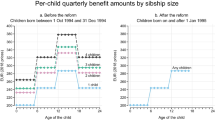Abstract
Bureau Common Reporting Requirements (BCRR) data tapes for Fiscal Year 1980 were analyzed to determine whether the type of sponsoring agency influenced the productivity or indicators of care of Maternity and Infant Care and Children and Youth Projects. Sponsors were classified as either health department or non-health department, health department or major medical center, or public or private in three separate sets of analyses. Some of these analyses indicated that special projects that were either health department or public agency sponsored were more likely to have more non-medical patient encounters and more health education and social work staff for a given level of expenditures. Although publicly sponsored projects employed fewer physician equivalents than did the non-public projects, those physicians were more productive. Despite these differences in encounters, staffing, and utilization of physicians, there were no differences in available measures of the process of care between categories of projects in any of the analyses.
Similar content being viewed by others
References
Maternal and Child Health Service,Promoting the Health of Mothers and Children. FY 1973, DHEW Pub. No. (HSA) 74-5002, Health Services Administration, Rockville, Md., 1973, p. 29.
Bureau of Community Health Services,Child Health in America, DHEW Pub. No. (HSA) 76-5015. Health Services Administration, Public Health Service, Rockville, Md., 1976, p. 59.
Maternal and Child Health Service,Promoting the Health of Mothers and Children, FY 1973, DHEW Pub. No. (HSA) 74-5002, Health Services Administration, Rockville, Md., 1973, p. 35.
Bureau of Community Health Services,Promoting the Health of Mothers and Children, FY 1973, DHEW, Pub. No. (HSA) 74-5002, Health Services Administration, Rockville, Md., 1973, p. 61.
Klerman, L., Title V. The Maternal and Child Health and Crippled Children's Services Section of the Social Security Act: Problems and opportunities, in select panel for the promotion of child health,Better Health for our Children: A National Strategy, Vol. IV. Washington, D.C., USDHHS/Office of the Assistant Secretary for Health and Surgeon General, DHHS (PHS) Pub. No. 79-55071, 1981, pp. 613–614.
Bronstein, E.S., Factors in the reduction of infant mortality in a maternity and infant care project.J. Med. Assoc. Ga. 63:435, 1963.
Chabot, A., Improved infant mortality rates in a population served by a comprehensive neighborhood health program.Pediatrics 47:989, 1971.
Dever, G.E.A., Rousseau, R., Koplow, W., and Brown, A., Maternal and infant care project evaluation: Georgia 1974–1977. Health Services Analysis, Inc., Atlanta, 1980.
Gold, E.M., Stone, M.L., Rich, H., Total maternal and infant care: An evaluation.Am. J. Pub. Health 59:1851, 1969.
Peoples, M.D., and Siegel, E., Measuring the impact of programs for mothers and infants on prenatal care and low birth weight: The value of refined analysis.Med. Care 21:586–608, 1983.
Sokol, R.J., Woolf, R.W., Rosen, M.G., and Weingarden, K., Risk, antepartum care, and outcome: Impact of a maternity and infant care project.Obstet. Gynecol. 56:150, 1980.
Vaughn, B.J., Maternal and infant care project: Results in Dade County, Florida.South. Med. J. 61:641, 1968.
Kaplan, R.S., Lave, L.B., and Leinhardt, S. The efficacy of a comprehensive health care project: An empirical analysis.Am. J. Pub. Health 62:924–930, 1972.
Gordis, L., Effectiveness of comprehensive care programs in preventing rheumatic fever.New Engl. J. Med. 289:331–335, 1973.
Morehead, M.A., Donaldson, R.S., and Seravalli, M.R., Comparisons between OEO neighborhood health centers and other health care providers of ratings of the quality of health care.Am. J. Pub. Health 61: 1294–1306, 1971.
Bailey, S., The Maternal and Child Health Services Block Grant, Title V of the Social Security Act, Library of Congress, Washington, D.C., Congressional Research Service Report No. 83–93 EPW, May 5, 1983, p. 15.
Instruction Manual for the BCHS Common Reporting Requirements, Rockville, Md., USDHEW/PHS/HSA/BCHS, January, 1980, p. 1.
Grossman, M., and Goldman, F., The production and cost of ambulatory medical care in ambulatory health centers. Paper presented at the Annual Meeting of the American Public Health Association, Montreal, Canada, Nov. 15, 1982.
Author information
Authors and Affiliations
Rights and permissions
About this article
Cite this article
Kotch, J.B., Coulter, M.L., Porter, C.Q. et al. Productivity and selected indicators of care in Maternity and Infant Care and Children and Youth Projects according to sponsorship. J Med Syst 12, 285–294 (1988). https://doi.org/10.1007/BF00996579
Issue Date:
DOI: https://doi.org/10.1007/BF00996579




